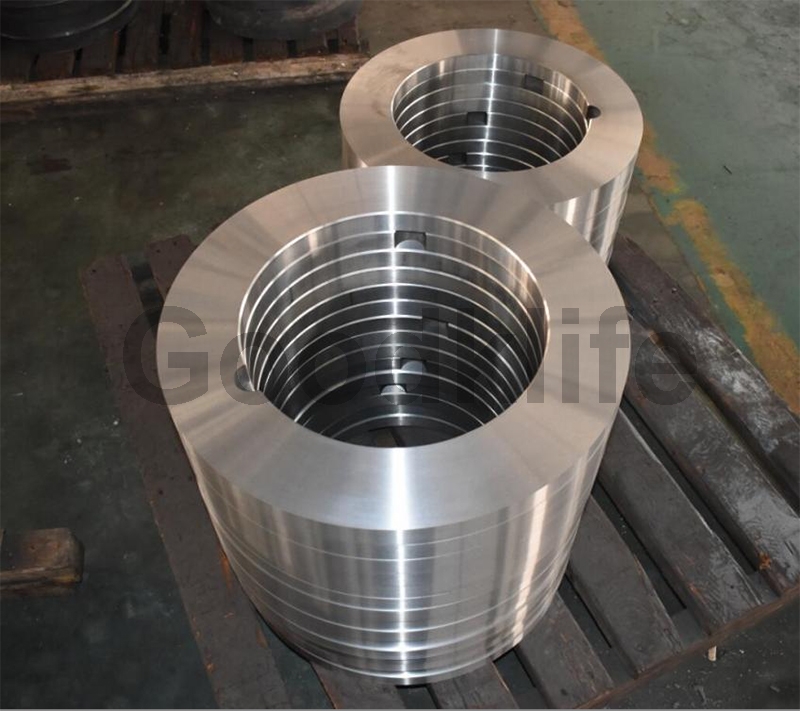Everything You Need to Know: Sawing and Shearing
Views : 2900
Update time : 2022-01-21 18:31:45
If you're a metalworker, then you're no stranger to sawing. As two of the most common manufacturing processes in the metals industry, sawing and shearing provide consistent, accurate cuts on a large scale across a wide range of industries. What exactly are these processes involved? How effective are they?

slitting knives cut steel
Metal band saws are known for cutting raw metal into manageable sizes and cutting bars and tubes to length. The band saw is equipped with a number of fine, slightly curved teeth that are ideal for cutting copper, aluminum, thin-walled brass and other non-ferrous metals.
Vertical band saws: These saws, also known as contour saws, keep the blade path stationary as the metal moves across it. This type of saw can be used for more complex cutting jobs, including polishing, filing and cutting precise contours of the metal.
Band saws greatly reduce waste because they provide a smaller kerf than other cutting processes. While the wider blades used in other saw types increase waste by consuming more material, the narrower blades of band saws reduce waste.

slitting blade for steel cut
When the metal is inserted into the hydraulic shear, the metal is held in place by strong clamps to prevent movement under strong pressure. To ensure a uniform and smooth cut with a 90 degree cut, a backstop or right angle arm is used.
Goodklife has always been committed to providing high productivity and high precision tools and inserts. From raw materials and heat treatment to finishing, Goodklife tracks and tightly controls each piece to improve the performance and productivity of our products while reducing production costs. Please send us a message to sales@goodklife.com, and we'll reply to you soon.
- Slitting Line Tooling manufacturer Goodklife shows you.

slitting knives cut steel
Sawing Process
In the metal industry, band sawing is one of the main methods used to cut metal materials. The process involves the use of a power saw with a long, sharp blade consisting of a continuous band of toothed metal stretched between two or more wheels. This provides a uniform cut due to the evenly distributed tooth load.Metal band saws are known for cutting raw metal into manageable sizes and cutting bars and tubes to length. The band saw is equipped with a number of fine, slightly curved teeth that are ideal for cutting copper, aluminum, thin-walled brass and other non-ferrous metals.
Types of band saws
Horizontal band saws: These saws keep the metal stationary while the blade swings down through the kerf. This configuration is used to cut long materials, such as pipe or bar stock, and to cut the raw material to length to fit the size requirements.Vertical band saws: These saws, also known as contour saws, keep the blade path stationary as the metal moves across it. This type of saw can be used for more complex cutting jobs, including polishing, filing and cutting precise contours of the metal.
Band saws greatly reduce waste because they provide a smaller kerf than other cutting processes. While the wider blades used in other saw types increase waste by consuming more material, the narrower blades of band saws reduce waste.

slitting blade for steel cut
Shearing process
Shearing is another common method of cutting metal. In the shearing process, an upper shearing blade and a fixed lower blade are forced to pass through each other at a certain offset to remove a portion of the raw metal. Hydraulic shears are used to cut, bend, press and stamp sheet metal and plate. Metals that are typically sheared include: stainless steel, aluminum, brass, bronze, etc.When the metal is inserted into the hydraulic shear, the metal is held in place by strong clamps to prevent movement under strong pressure. To ensure a uniform and smooth cut with a 90 degree cut, a backstop or right angle arm is used.

Types of shearing machines
Guillotine design
This type of shear is usually more expensive, more accurate, and has greater shearing capacity. Guillotine shears are designed with a drive system that ensures that the upper blade passes directly through the material from start to finish. A key feature of guillotine shears is the ability to adjust the cutting angle of the top blade. This facilitates greater accuracy while reducing distortion.Pendulum beam design
This type of shear is typically less expensive and is ideal for cutting thinner materials 1/4 inch and below. On a swing beam shear, the swing beam moves in a circular arc with the upper blade and penetrates the lower blade of the sheet metal above, allowing for faster strokes per minute. Unlike the guillotine design, front angle adjustment is not available.Goodklife has always been committed to providing high productivity and high precision tools and inserts. From raw materials and heat treatment to finishing, Goodklife tracks and tightly controls each piece to improve the performance and productivity of our products while reducing production costs. Please send us a message to sales@goodklife.com, and we'll reply to you soon.


